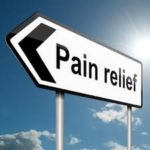Becoming Pain-Free by Dr. Shelah Deans, ND

Dr. Shelah Deans, ND graduated from Bastyr University with a doctorate in Naturopathic Medicine. She is part of the team at Yellowstone Naturopathic Clinic as a first year resident, specializing in both family and regenerative medicine. She also has over 15 years experience in the health and fitness industry working with corporate executives, busy moms, and professional athletes in achieving their goals. Her passion is practicing evidence-based, integrative medicine while helping patients live their best life possible, preventing disease and mitigating pain.
Are aches and pains keeping you from living your best life? Struggling with nagging, old injuries that still bother you? This article will be a brief discussion on the science behind pain followed by various strategies at becoming pain-free.
Why does the body have pain and what is the purpose? To answer this, let’s use the analogy of a car. When something is wrong with the engine, what happens? The check engine light goes on, which lets the driver know that engine should be checked in order to prevent damage. Snipping the wire for the check engine light will remove the annoyance of having the light on, but that could increase the risk of destroying the engine. A better option is to open the hood and run diagnostics to figure out what is happening with the engine then appropriately address the concern. Likewise, pain is your body’s check engine light.
When discussing musculoskeletal pain, several chemicals are released and are linked to the sensation of pain, such as: histamines, prostaglandins, bradykinin, and most notably, Substance P. These chemicals cause nerves to fire and alert the body of injury, sending continuous, unrelenting pain signals. Thus a reasonable strategy to reduce or relieve pain is to alter these chemicals, while simultaneously addressing the underlying reason pain signals are being sent in the first place.
Since pain is complex and quite variable, there is no one-size-fits-all, so it’s important to have the correct diagnostics run (just as one would for their vehicle). Assessing musculoskeletal pain involves an evaluation of the joints and consideration of system-wide contributing factors. Once the underlying cause is determined, one can begin the strategic and individualized approach to relieving pain.
As for treatment, the options are seemingly endless and can include anything from vitamins to surgery. Here is a list of effective strategies for addressing pain: nutrition, exercise and corrective movements/physical therapy, and other physical modalities that are useful, such as: hydrotherapy, cold laser, infra-red light/laser, cranial sacral and visceral therapy, sound therapy, acupuncture, dry needling, perineural injections, and regenerative injection therapy (prolotherapy, platelet rich plasma, stem cells and stem cell derived products).
There are also supplements that aid in pain relief, which include vitamins and herbal medicine. And not to forget, homeopathy. So, as u can see, there are endless options. Not sure where to start? Wondering what’s right for you? This is a vast topic, which can be discussed with your health care provider and naturopathic doctor.
As always, wishing you joy on the journey and may you find the right path for you in becoming pain-free!

Clinic